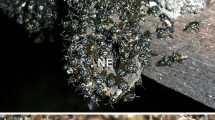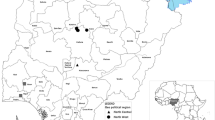Abstract
Workers ofMelipona fasciata andM. interrupta triplaridis respond to their respective mandibular gland extracts with alarm recruitment and defensive behavior. Workers rapidly exit from the nest entrance, land on an intruding object, and bite with the mandibles while vibrating the flight muscles. These behaviors are accompanied by the release of the contents of the mandibular glands. Colonies of both species exhibited greater response to their own mandibular gland extracts than to those of other stingless bee species. Chemical analysis identified 2-heptanol as the major component in hexane extracts of each species. Undecane was a constituent of both species; skatole and nerol were identified only in extracts ofM. i. triplaridis.
Similar content being viewed by others
References
Baroni Urbani, C. 1979. Territoriality in social insects, pp. 91–120,in H.R. Herman (ed.). Social Insects. Academic Press, New York.
Bergstrom, G., andLovquist, J. 1971.Camponolis ligniperda Latr. A model for composite volatile secretions of Dufour's gland in formicine ants, pp. 195–223,in A.S. Tahori (ed.). Chemical Releasers in Insects. Proc. 2nd Int. IUPAC Cong. Pest. Chem. in Tel Aviv. Vol. 3. Gorden & Breach, New York.
Blum, M.S. 1966. Chemical releasers of social behavior. VIII. Citral in the mandibular gland secretion ofLestrimelitta limao.Ann. Ent. Soc. Am. 59:962–964.
Blum, M.S. 1970. The chemical basis of insect sociality, pp. 61–94,in M. Beroza (ed.). Chemicals Controlling Insect Behavior. Academic Press, New York.
Blum, M.S. 1979. Hymenopterous pheromones: Optimizing the specificity and acuity of the signal, pp. 201–211,in F.J. Ritter (ed.). Chemical Ecology: Odour Communication in Animals. Elsevier/North Holland.
Blum, M.S., andBrand, J.M. 1972. Social insect pheromones: Their chemistry and function.Am. Zool. 12:553–576.
Blum, M.S., Crewe, R.M., Kerr, W.E., Keith, L.H., Garrison, A.W., andWalker, M.M. 1970. Citral in stingless bees: Isolation in trail laying and robbing.J. Insect Physiol. 16:1637–1648.
Boch, R., andShearer, D.A. 1966. Iso-pentyl acetate in stings of honeybees of different ages.J. Apic. Res. 5:65–70.
Boch, R., Shearer, D.A., andStone, B.C. 1962. Identification of iso-amyl acetate as an active component in the sting pheromone of the honeybee.Nature 195:1018–1020.
Duffield, R.M., Blum, M.S., Wallace, J.B., Lloyd, H.A., andRegnier, F.E. 1977. Chemistry of the defensive secretion of the caddisflyPycnopsyche scabripennis (Trichoptera: Limnephilidae).J. Chem. Ecol. 3:649–656.
Gary, N.E. 1974. Pheromones that affect the behavior and physiology of honey bees, pp. 200–221,in M.C. Birch (ed.). Pheromones. American Elsevier, New York.
Grandperrin, D., andMauchamp, B. 1982. The Koschewnikow gland as the principal organ secreting the sting alarm pheromone in the honeybee worker (Apis mellifera L.), p. 333,in M.D. Breed, C.D. Michener, and H.E. Evans (eds.). The Biology of Social Insects. Westview Press.
Johnson, L.K. andWeimer, D.F. 1982. Nerol: An alarm substance of the stingless beeTrigona fulviventris (Hymenoptera: Apidae).J. Chem. Ecol. 8:1167–1181.
Keeping, M.G., Crewe, R.M., andField, B.I. 1982. Mandibular gland secretions of the old World stingless bee,Trigona gribodoi Magretti: Isolation, identification, and compositional changes with age.J. Apic. Res. 21:65–73.
Kerr, W.E., andde Lello, E. 1962. Sting glands in stingless bees—a vestigal character.J. N. Y. Entomol. Soc. 70:190–214.
Koeniger, N., Weiss, J., Maschewitz, U. 1979. Alarm pheromones of the sting in the genusApis.J. Insect Physiol. 25(6):461–542.
Michener, C.D. 1974. The Social Behavior of the Bees. Harvard University Press, Cambridge, Massachusetts. 404 pp.
Parry, K., andMorgan, E.D., 1979. Pheromones of ants: A review.Physiol. Entomol. 4:161–189.
Roubik, D.W. 1981. New species ofTrigona and cleptobioticLestrimelitta from French Guiana (Hymenoptera: Apidae).Rev. Biol. Trop. 28:263–269.
Sakagami, S.F., andLaroca, S. 1963. Additional observations on the habits of the cleptobiotic stingless bees, the genusLestrimelitta Friese.J. Fac. Sci. Hokkaido Univ. (VI, Zool.), 15:319–339.
Weaver, N., Weaver, E.C., andClarke, E.T. 1975. Reactions of five species of stingless bees to some volatile chemicals and to other species of bees.J. Insect. Physiol. 21:87–94.
Wilson, E.O. 1971. The Insect Societies. Harvard University Press, Cambridge, Massachusetts.
Author information
Authors and Affiliations
Rights and permissions
About this article
Cite this article
Smith, B.H., Roubik, D.W. Mandibular glands of stingless bees (Hymenoptera: Apidae): Chemical analysis of their contents and biological function in two species ofMelipona . J Chem Ecol 9, 1465–1472 (1983). https://doi.org/10.1007/BF00988512
Received:
Revised:
Issue Date:
DOI: https://doi.org/10.1007/BF00988512




